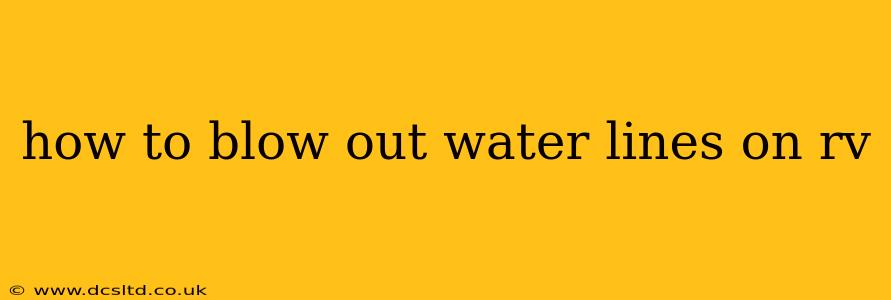Protecting your RV's plumbing system from freezing temperatures is crucial to prevent costly repairs. Blowing out your water lines with compressed air is a highly effective method. This comprehensive guide will walk you through the process step-by-step, ensuring you winterize your RV correctly.
Why Blow Out Your RV Water Lines?
Freezing water expands, and this expansion can cause pipes to burst, leading to significant damage and expensive repairs. Blowing out your water lines removes all water from the system, preventing this damage. This is especially important in colder climates where temperatures regularly drop below freezing.
What You'll Need to Blow Out Your RV Water Lines
Before you begin, gather the necessary supplies:
- Air compressor: A portable compressor capable of delivering at least 90 PSI is recommended. Check your compressor's manual to ensure it can handle the task.
- Air chuck with a blow gun: This will connect your compressor to the RV's water system. A longer blow gun allows you to reach various valves more easily.
- Low-pressure regulator (optional but recommended): This helps prevent damage to your RV's plumbing system by regulating the air pressure.
- RV antifreeze (optional): While blowing out the lines is the primary method, some RVers add a small amount of antifreeze as an extra precaution.
- Water hose: To flush out the system before blowing it out.
- Towels: To absorb any residual water.
- Safety Glasses: Protect your eyes from potential debris.
Step-by-Step Guide on How to Blow Out RV Water Lines
1. Prepare Your RV:
- Turn off the water pump: Ensure the water pump switch is in the "off" position.
- Drain all water tanks: Completely empty your fresh, gray, and black water tanks.
- Open all low-point drains: Locate and open all low-point drains on your RV. These are typically located underneath your RV.
- Open all faucets: Turn on all faucets, both hot and cold, inside and outside your RV. This includes shower heads and toilet valves.
2. Flush the System:
- Connect a hose: Connect a garden hose to a city water connection and turn on the water to flush the system. This removes any loose sediment or debris.
3. Connect the Air Compressor:
- Attach the air chuck and blow gun: Connect the air chuck to your compressor and attach the blow gun to the air chuck.
4. Start Blowing Out the Lines:
- Connect to the highest point: Connect the blow gun to your highest water line access point (usually at the city water hookup).
- Turn on the compressor: Slowly turn on your compressor and monitor the pressure. Never exceed the recommended pressure for your RV’s plumbing system (consult your owner’s manual).
- Listen for the air: As you blow out the lines, you'll hear a change in the sound as the water is purged and only air is passing through.
- Check all faucets: Move to each faucet and make sure air is blowing freely.
5. Disconnect the Compressor:
- Turn off compressor and disconnect: Once air is flowing freely from all faucets, shut off the compressor and disconnect the air chuck and blow gun.
6. Add Antifreeze (Optional):
- Some RVers add a small amount of RV antifreeze to the system as an extra precaution. However, remember that proper air blowing should eliminate the need for this.
7. Final Checks:
- Close low-point drains: Carefully close all low-point drains after blowing out water lines.
- Inspect for leaks: Inspect all connections and pipes for any signs of leaks or damage.
How Long Does it Take to Blow Out RV Water Lines?
The time required depends on the size and complexity of your RV's plumbing system, but generally, it takes between 30 minutes to an hour to complete the process properly.
What if I Don't Have an Air Compressor?
If you don't have access to an air compressor, you'll need to use RV antifreeze and completely fill your water system with it. Refer to your RV's owner's manual for instructions on how to properly winterize your RV without an air compressor. This method requires more antifreeze and more time but is still effective.
How to Blow Out Water Lines on a Specific RV Component (e.g., Water Heater)?
Many RVs have separate access points for specific components such as the water heater. Consult your RV’s owner’s manual for specific instructions on blowing out the water heater. Often, there's a drain valve specifically for the water heater.
This comprehensive guide should help you safely and effectively blow out your RV's water lines. Remember to always consult your RV's owner's manual for specific instructions and safety precautions. Proper winterization will protect your investment and ensure your RV is ready for the next season.
